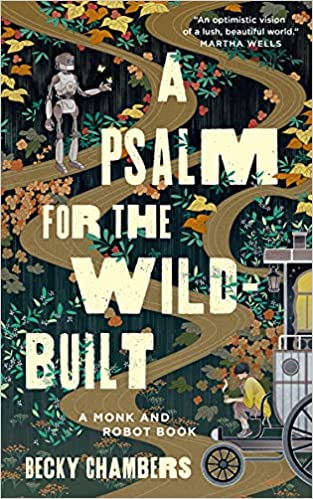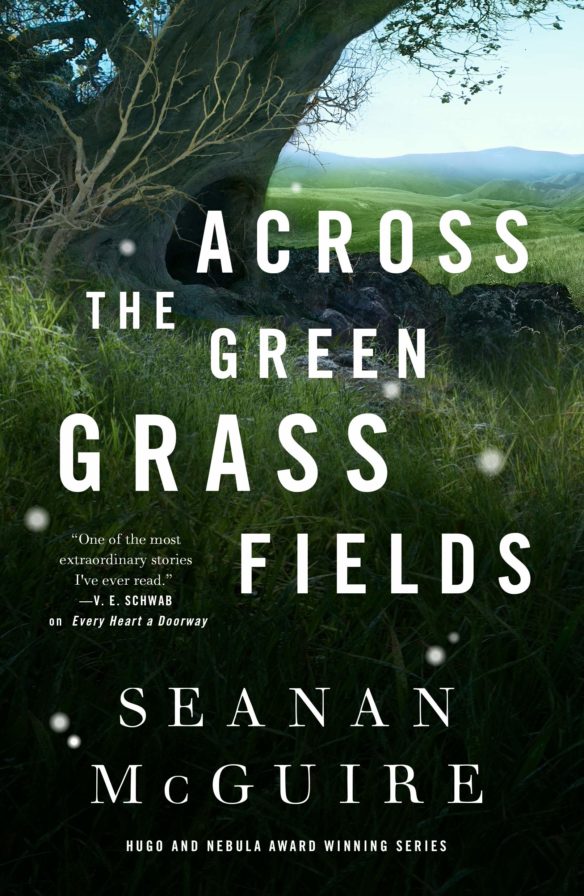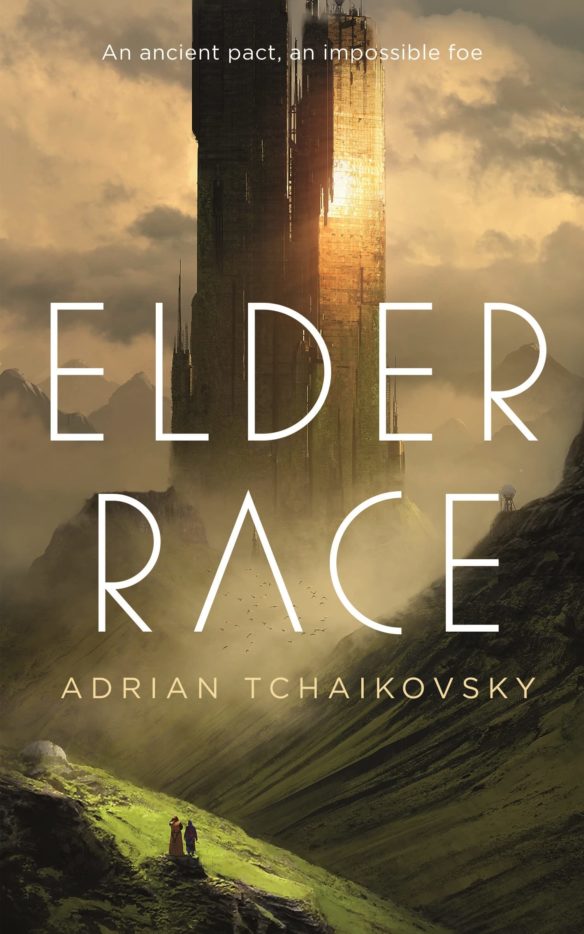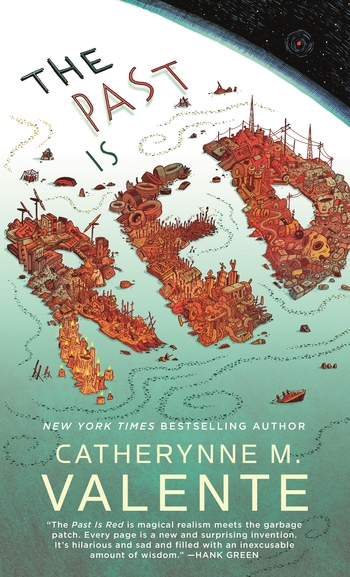[Introduction: In Michaele Jordan’s overview, she comments on the novellas by Aliette de Bodard, Becky Chambers, Alix E. Harrow, Seanan McGuire, Adrian Tchaikovsky, and Catherynne M. Valente that are up for the 2022 Hugo.]
By Michaele Jordan:

Fireheart Tiger, by Aliette de Bodard (Tordotcom) is a high fantasy. You’ve probably noticed that fantasy has become such a broad field that it can be broken down into subtypes, such as urban fantasy, Tolkienesque fantasy, dragon stories or fairy tales. High fantasy, in particular, has a specific format. It’s always set in a low-tech world – often here on earth, within a particular historical era. It always focuses on the adventures of the ruling class, usually royalty. The magic is often minimal compared to other types of fantasy, as it must be woven into the political or military struggles, and the court intrigues, with which the high-born characters are preoccupied.
High fantasy tends to further subdivide into two types: costume romances (usually of the forbidden kind) overlaid with magic, or political thrillers, also overlaid with magic, but with a great deal of plotting, backstabbing, and poison. In both cases, the characters are hugely constrained by their class obligations, and a lot of attention is paid to their expensive clothing, their plush living conditions, and the loyalty (or lack thereof) of servants.
If you are a fan of high fantasy – and many of us are – then you will love Fireheart Tiger. The protagonist is a young princess, caught up in a turbulent, and possibly treasonous, affair with another princess, even as their two countries circle each other, looking for attack points. The setting is highly original –an analog of pre-Colonial Viet Nam, (around 18th century). The magic is also well handled. There are no spells or amulets. But one of the three major characters is a fire elemental – and a VERY interesting character.

Next we come to A Psalm for the Wild-Built, by Becky Chambers (Tordotcom), I loved it! First and foremost: I was struck by the tale’s charm. The characters are charming. Their culture is charming. Their tea monks are charming. Even the opening, where Sibling Dex notices the absence of crickets is charming. Most of all, the voice in which the story is told charming, full of love and attention to captivating details.
The story seems to take place on earth, in a way-past-the-apocalypse future. Not that the author ever said as much! It may not even be intentional. She may only have wanted it to be earthlike enough to make us feel at home. In which case, she succeeded.
They have a lush ecology, with plants that are not just generic but species that seem familiar to us (especially herbs). The animals seem familiar, too (especially the insects, and not just crickets). There is a complex history of over-industrialization leading to collapse, followed by recovery.
But the place where all those charming things live is actually Pangan (named after one of the local gods). It’s a moon orbiting Motan (also named after a god) which appears to be a gas giant. (For me, the discovery that this is not Earth was genuinely startling. The place feels so homelike it’s almost deja vu.)
Naturally, this means that the inhabitants are not human, per se, but they, too, are so vividly evoked that it’s hard to believe. Sibling Dex does not merely seem to be someone we might know. They feel like . . . well, a sibling. Even Splendid Speckled Mosscap – who could not be mistaken for a human , no matter how quickly the reader is skimming – feels friendly and comfortable.
The story is soft and simple. (If you’re looking for epic battles, go elsewhere.) There is a quest, which involves some very hard travelling into the wilderness. Some of the creatures in the wilderness are more dangerous than charming.
While on the road, Dex and Speckled Mosscap have a lot of time to talk. Speckled Mosscap wants to know why Dex is engaging in their strange and whimsical quest. Dex wants to know where Speckled Mosscap has come from, and why nobody has seen any of their people before. Both are wondering if it is time for Speckled Mosscap and their people to re-emerge into Pangan life.
Their conversation – along with the ending – is philosophical, revolving around such eternal questions as “life, the universe and everything.” The conclusion does not offer any answers, but leaves us very content, just the same.

A Spindle Splintered, by Alix E. Harrow (Tordotcom) starts with an excellent concept. We’ve all seen tales – many, many tales – of young women entering Fairyland, by a variety of means and with a variety of motives. This time, the traveler is propelled by soul-crushing need. She was born with a genetic disorder that invariably kills its victim before the age of twenty-two, at the very latest, and usually much younger. The story opens on the protagonist’s twenty-first birthday.
All her life, Zinnia has been obsessed by the story of Sleeping Beauty. She knows that it’s a terrible story in many ways – most notably in that it makes its heroine a virtual walk-on (or should I say a sleep-on?) in her own story. She knows there are versions of the story much darker and crueler than Disney’s. But nonetheless, she identifies desperately with Sleeping Beauty, who has spent her entire short life watching and waiting for the inevitable curse to strike her down.
Zinnia’s best friend wants her twenty-first birthday to be special, and arranges a Sleeping Beauty birthday party smothered in roses, and complete with a haunted tower and an antique spinning wheel. In a moment of dark whimsy and drunken bravado, Zinnia deliberately presses her finger to the spindle.
In an ineffable moment of spinning within the multiverse, she sees a thousand cursed princesses reaching for the spindle. But only one protests, softly whispering, “Help.” So Zinnia reaches out towards her. The universe goes dark, and she wakes in a fairy tale castle, in the plush royal bed of Princess Primrose of Perceforest.
If this tale has a flaw it starts now. After a truly compelling opening, Ms. Harrow has no place left to go. She has a point that she cares about, and wants very much to make. She has already intervened in the original story before the end, which she wants to change – that being her whole purpose in writing this novella. But fairy tales are not strong on complex plot lines, and now she has no guideposts as to where to go next, or how to get there.
In this place and time, the only alternative to the spindle is a political marriage. So if there is to be any story at all, it must now decry its new ending and find a way to avert it.
Mind you, I’m not suggesting that loveless political marriages are a good thing. But I do not think that was Ms. Harrow’s original point. And they are a far cry from a terrible curse. They were normal in the Middle Ages, where large households were as close as woman could get to a safe refuge in a dangerous world. The only reasonably acceptable alternative was the nunnery, (which apparently was not an option in fairy tale worlds.)
I fully acknowledge that Primrose’s position is not a happy one. But she has been dropped into a much weaker story than the one she started out in, which is disappointing to the reader. And it is still a story that can only be resolved by magic.
Lastly, I am sorry to say, I found the ending even weaker. Primrose is (magically) rescued. Zinnia emerges from her adventure with a few years added to her potential lifeline, and some personal lessons learned. But lessons learned are not the same thing as skills acquired, and she would need some serious skills when embarking on her next life choice – which mostly looks like a bid for a sequel.

Across the Green Grass Fields, by Seanan McGuire (Tordotcom), is also a tale of a young girl entering Fairyland. The similarities end there. Regan is only ten. Unlike a number of her classmates, she’s still definitely pre-teen. (Allow me to interject that Ms. McGuire’s portraiture of young girls is uncanny in its accuracy.) But as long Regan’s best friend is Laurel, the class queen bee, she is sheltered from social consequences, and no matter that Laurel is a rigid, domineering bully.
That is, until Regan’s parents have to warn her that there is a genetic reason why she is not maturing as fast as her classmates. That discovery was the end of her world. The end of her friendship with Laurel—and the end of the social safety Laurel provided. She runs away from home. And in a nearby wooded plot she finds . . . a door.
It doesn’t lead to a fairyland of castles and princesses. Rather, it’s simply a place where the residents are all mythological beings, and there are no humans. She stumbles almost immediately upon a unicorn, (which is not a person, it’s a dumb beast) and shortly afterwards, the centaurs who herd the unicorns. The centaurs are all astonished and thrilled to meet a genuine human. They know the legends. Humans only show up when the serious trouble is coming and they’re needed to save the world, after which they disappear. Which may bode ill, but it’s still thrilling to meet a creature out of legend.
The centaurs offer to take Regan to see the queen, right away, since she will have to be presented to Her SunLit Majesty sooner or later anyway. But Regan would rather stay with the centaurs, at least until the Fair. She becomes best friends (true best friends!) with Chicory, a centaur child, and studies herbal medicine with Daisy, the herd’s healer. She learns centaur customs, and how to herd unicorns and, weave grass beds. She grows tall and strong, and doesn’t bother to worry about the absence of puberty. She does worry how her parents are coping, but there’s nothing she can do about that. This continues for years.
The story here is deceptively simple. Regan runs away and arrives in another world. She learns many lessons about herself – most importantly, how to be happy insider her own skin – and in the end, she must go to the Fair to meet the queen. The Fair is not as safe and kindly a place as a centaur longhouse. And the queen is not what Regan has been told. I am struggling here to avoid spoilers while warning you that the ending is startling unique: smaller and subtler – and sharper – than you’d expect, but quite wonderful.

In Elder Race, by Adrian Tchaikovsky (Tordotcom), Mr. Tchaikovsky applies well known trope: an abandoned colony reduced of millennia to pre-industrial barbarism, but with one lingering outpost, inhabited by one lone anthropologist named Nyrgoth, who long since abandoned hope of his people ever coming back.
The last time Nyr ventured out of his tower, he was persuaded to accompany a warrior princess named Astresse in her pursuit of a monster/sorcerer/warlord Ulmoth. Ulmoth was defeated and Nyr has filled the centuries since with long naps. Our story opens with Lynesse, the great-granddaughter of Astresse, deciding that it is time to solicit more ‘sorcerous’ assistance against an apparently magical menace.
The story shifts focus back and forth between Nyr and Lyn. I found this format a little troubling, largely because the two parties didn’t balance. The Nyr passages are a deeply intimate first-person memoir.
He cannot look at Lyn without remembering Astresse, and grieving that she is so long gone. He agonizes over the endless struggle to communicate with her, since she interprets all technical terms as magical ones. (He must have had the same problem with Astresse, but apparently never got used to it.)
He flagellates himself over his failure as an anthropologist, in that he has intervened (twice now!) in the culture he is supposed to be studying, while simultaneously denouncing the pointlessness of anthropological study. Psychologically, he is a clinically depressed mess.
But Lynn, on the other hand, is presented in a brisk third person. She is a fairly standard heroic fantasy protagonist, an unappreciated younger heir, raised on tales of her heroic ancestress, questing in the hope of proving herself to her family, and gaining renown. Her emotions and responses are plain, and undetailed.
The monster is interesting – although not much attention is paid to it. No one who has not seen it believes in it, largely because it is truly weird, well beyond the normal bounds of either SF or fantasy. The pair painfully but successfully defeat it, seeming at great cost. But of course, a happy ending is tacked on, and all is joy in Mudville.

The Past Is Red, by Catherynne M. Valente (Tordotcom), is complicated. In fact, it’s so complicated that I had a lot of trouble following it. And, therefore, I can’t really say I enjoyed it. It breaks my heart to say that. Ms. Valente is one of my favorite authors. Radiance (Tom Doherty Associates, 2015) and Deathless (Tordotcom, 2011) are two of the best books I have ever, EVER read.
But . . . for starters, she uses a very convoluted sequence of events. She jumps around in her story line so vigorously that I spent a good half of my reading time going back to reread previous passages in a frequently unsuccessful attempt to find out where I was in the story. On top of that, she used what may have been the most unreliable ‘unreliable narrator’ I have ever encountered.
Usually I don’t mind an unreliable narrator. It adds verisimilitude. Mind you I’m quite comfortable with the impersonal third person narrator, but using one of the characters as the narrator can bring warmth into a story. In real life, a lot of people don’t know much, and usually don’t want to admit that. Why should a well-drawn character be any different?
But . . . on three separate occasions, the protagonist announced, “None of that is true. I just made it all up because I like it better than what really happened.” There was no knowing how much was covered under “that” and “it all.” Maybe everything? I’m still not sure what (if anything) happened in The Past is Red.
Maybe I was just feverish or sleep deprived. Maybe you’ll do better with it. I hope so. I do so love her.
Discover more from File 770
Subscribe to get the latest posts sent to your email.
